  |

|
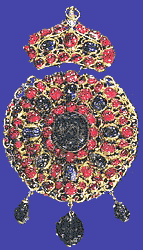
Fig. 1 Pectoral of
Metropolitan Parthenios of Caesaria. Greek work from
Constantinople. The perforated double-sided pectoral is
decorated on one side with precious stones-rubies, sapphires,
emeralds- and on the other with painted enamels and
representations of the Holy Trinity and the Desis.
1738
Athens Benaki Museum, inv. no. T.A. 147.
|
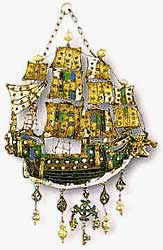
Fig. 2 Gold pendant
from Patmos, Three-masted caravel with open sails decorated with
coloured enamels and pearls. Such jewellery, worked by Greek
craftsmen probably in Venice from Western designs, was worn in the
Dodecanese and Cycledes islands during the 17th and 18th
centuries. 17th-18th century.
Athens Benaki Museum, inv. no. 7669.
|
|
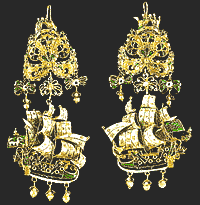
Fig. 3 Gold earrings
from Siphnos, . Three-masted caravels with multicolored enamels and
pearls. Ornate surfaces like transparent gold lace with enameled
details echo the influences of European rococo sailing ships hang
from bows topped by a crown.
17th-18th century
Athens Benaki Museum, inv. no. 7670.
|
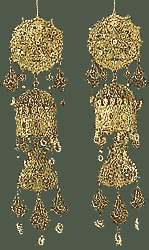
Fig. 4 'Kambanes' (Bells) from Kos, .
Sumptuous long earrings that frame the face as in the Byzantine
imperial 'perpendulia'. Ornate compositions are fashioned in
delicate gold filigree and perforated technique.
18th century
Athens Benaki Museum, inv. no. Exp. 265.
|
|
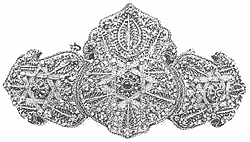
Fig. 5 Belt buckle from Cyprus.
Athens Benaki Museum, inv. no. Ea. 117.
|
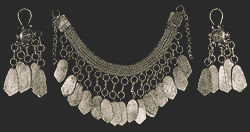
Fig. 6 Necklace and earrings from Macedonia.
Strking silver jewellery, simple forms with large pendent metal
plaques. Greek craftsmen worked mainly in silver, pure or low-grade,
copper or bronze, in accordance with the client's wishes.
18th-19th century
Athens Benaki Museum, inv. nos Ea. 704, 871.
|
The Neohellenic jewellery in museums and private collections
is distinguished by its impressive quality and remarkable variety. Many of these
rare and precious pieces are published and so known in the bibliography.
Spanning a broad continuum in space and time, they illustrate aspects of both
Turkish-occupied Greece and the Hellenic diaspora after the fall of Byzantium in
1453.
These exquisite objects, valuable reflections of the panorama
of Hellenism, include not only jewellery wrought by native craftsmen but also
that of foreign origin which was incorporated in the Greek tradition, remodeled
and adapted, its variations taking their place alongside ancient Greek and
Byzantine memories in the artistic history of this land.
The tradition of silver- and goldsmithing in Greece is lost in the mists of
time. In Greek mythology Hephaestus, god of fire, the `divine smith', appears as
the inventor of metalworking. In his Olympian forge he fashioned such
magnificent works as Achilles' shield, Herakles' golden breastplate, Zeus'
sceptre and throne, Ariadne's wedding crown. In the course of 5,000 years
miniature creations in metal, noble or base, have made their mark on Hellenic
civilization.
In more recent times, among the elements composing the
distinctive character of Neohellenic art (16th - late 19th century) the deeply
ingrained Byzantine tradition merits special mention. Heir to the an of ancient
Greece, it in its turn bequeathed to posterity forms and shapes, colors and
materials, imprinted in new creations. Diverse influences of Western
inspiration, nurtured by and filtered through Greek antiquity, also reached
Greece via the Venetian-held territories, while the later invasion of baroque
and rococo traits from Italy and Central Europe, as well as the impact of the
highly decorative aesthetic of Islamic an, were readily assimilated by the
skilful Greek craftsmen.
|
|


|
Greece jewellery pages Copyright ©
by Add
Information Systems. (Greece)
|
|
  |

